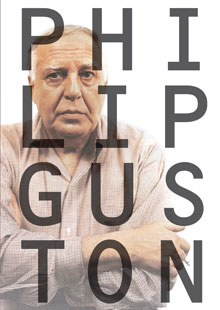
VALUABLE DOUBTS Guston always speaks subjectively — from his own struggles, his own studio, and from the art he made. |
If you are interested in the great painter Philip Guston (1913–1980), you will want this book. If you are interested in American painting from 1945 on, and into the future, you will want this book. If you enjoy a great talker in top form, you will want this book.
During the 1970s, when he came to Boston from his Woodstock (New York) fastness to teach painting at Boston University, Guston and I sat in my kitchen eating, drinking, smoking, and talking the candle down. He began talking about the food — he loved to eat and was himself a good cook — and moved on to what was on his mind, perhaps a run of current paintings, and then to Piero, Kafka, Rembrandt, Mantegna, Isaac Babel, Uccello, Richard Nixon, Fellini's I vitelloni, the golem, and — when I could get him to — tales of the New York School painters I so admire.
His talk always turned to doubt, Guston's constant and generative companion. If you graphed one of those nights, steep declines would follow sharp ascents, only to rise again. Guston could turn on a dime. And as shown by the dialogue with Clark Coolidge — poet, close friend, collaborator, and superb editor of this book — Guston could put his gift for monologue aside and hold a conversation.
But he did like to hear himself talk. "Like" is too mild a word. He needed to hear himself talk. Guston loved words and was well read, but he did not talk to satisfy a desire for self-expression. He needed his own running commentary, and the comments of those he talked with, about his paintings — the give-and-take with composer Morton Feldman, critic Harold Rosenberg, poet Bill Berkson, and audience members who packed his slide shows during the 1960s and '70s.
Guston was a prodigy who spent little time in art school in Los Angeles before moving to New York in the 1930s. His generation of painters — Jackson Pollock (a friend from high school), Willem de Kooning, Franz Kline, Mark Rothko — hung out in cafeterias and bars, where they talked art. This was their grove of Academe. Guston's wife, Musa, once said, with a trace of bitterness over the hours he spent in gab, that the person who listened to Guston quickly became a friend.
Our nights together showed me how Guston needed to step as far outside himself and his work as he could in order to re-enter self and art through speech. This book stands alongside his art, especially the paintings of the 1960s and the figurative paintings of the 1970s for which he is today revered. It is a necessary companion to the outpouring of drawings and paintings he completed during those years. Readers will get neither explanation nor analysis. Guston is crystal clear about what he doesn't know or cannot understand about his art. What readers will get is this: "It's all my way of thinking. I'm very prejudiced, of course." Guston always speaks subjectively — from his own struggles, his own studio, and from the art he made. He accepts his contradictions, yet he wiggles like a worm on a hook of his own devising, attempting to state in other words what he really wants to say, however cryptic that statement will be.